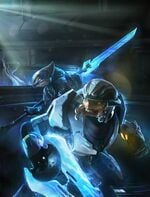Sangheili mythology
From Halopedia, the Halo wiki
| This article does not have enough inline citations and/or does not adhere to the proper citation format. You can help Halopedia by adding citations. |

This article is part of a series on
Sangheili
- Technology
- History
- Culture, Politics & Economy
To check out information for other sapient species, see here!
While much of Sangheili mythology has been subsumed by the Covenant faith, their ancient beliefs and traditions survived through the millennia of subsumation and neglect through various ways - among secretive societies, such as the Ascetic Order, through relict populations of unassimilated Sangheili such as the inhabitants of the Refuge (albeit in modified form), or through ancient records and carvings on the pre-Covenant monuments of Sanghelios. While suppressed by the Covenant during its existence, in the wake of its collapse these myths and traditions have been revived by a Sangheili cultural renaissance, even among the new Covenant factions.
Overview[edit]
Ancient Sangheili pantheon[edit]
The major deities of the original Sangheili pantheon was headed by the god-star Urs, who sired many demi-god heroes of Sangheili history, such as Kel 'Darsam.[1] Fied was also a god-star, that roamed the Hall of Eternity.[2] Sangheili mythology also venerated Ziggur, who was associated with nature.[3] The ancient Sangheili also adopted the Forerunners as gods, and held the Forerunner relics and facilities scattered across their planet as sacred, to the point of slaughtering San'Shyuum research teams that attempted to study them.[4]
Sangheili mythology also maintains the existence of beings that, while not considered gods in the conventional sense, are nevertheless supernatural in origin. Unexplained natural phenomena or geological formations are often attributed to supernatural causes or creators. The deadly current between the Dur'at'dur islands were believed to be caused by the endless thrashing of nine great serpents. According to legend, Kel 'Darsam slew the serpents, though the currents continued. Among Kel 'Darsam's other feats were the slaying of the Sand Dwellers of Il'ik and the many-mouthed Watcher of the Lonely Harbor.[1] Additionally, the Sangheili of the Nuusra region revered the Guardian buried beneath the Csurdon Sea and held the support machinery in the surrounding landscape sacred, and founded the city of Sunaion to safeguard the "Leevrukah," a demon that slept beneath the waves, through chanting, either to serve the Guardian or to protect others from its wrath. By 2552, despite being occupied by a revived form of the Covenant, the people of Sunaion continued their chants under the hope that they could keep the Guardian slumbering - a hope sundered by the invasion of the city by the Swords of Sanghelios, and then the activation of the Guardian by Doctor Catherine Halsey.[citation needed]
Silent Shadow mythology[edit]
During the Age of Seven Worlds, the Silent Shadow worshipped a nameless god said to wield a trikala - a three-bladed spear said to pierce the mind, soul, and body simultaneously in the past, present, and future. The Sangheili xenoarchaeologist Eto 'Saljhoo used this tale as inspiration when researching the ancient superweapon left on Netherop by the Precursors, naming the weapon the trikala.[5]
Ussan mythology[edit]
The beliefs of the Sangheili of the Refuge were based on those their ancestors had brought with them, but had changed significantly by 2552 when they made contact with their Sanghelios brethren. The Ussans were aware that the Forerunners had built the original Shield World that their ancestors had hoped to call home, and that the "Disassembly" had been part of its design - but that it had failed to form itself into its intended secondary configuration, a small ringworld resembling a Halo, showing that the Forerunners, while powerful, were not infallible.[6] Instead, Forerunner Sun and Forerunner Moon became the primary deities of their belief system, eclipsing the original Forerunners among Ussan believers.[citation needed] The Hall of Godminds was a sacred place where pilgrims went to pray to their gods and contemplate, filled with sculptures and holograms of various heroes of Ussan history - Ussa 'Xellus himself and his mate Sooln, Tersa 'Gunok and his mate, the female warrior Lnur 'Mol, a relief of Ernicka the Scar-Maker and other warriors slashing the traitorous Salus 'Crolon, and various floatfighter heroes of the past. Carvings depicted the home they had left behind, Sanghelios, cradled in Ussa 'Xellus's arms, and a relief of the Shield World shattering suspended by wire.[6] The remains of Enduring Bias, the "Flying Voice," were held there in a sphere of glass called the Homage to Enduring Bias,[7] who had become mythologized as a messenger of the gods.[citation needed]
A dissident offshoot, founded by a floatfighter called 'Greftus, believed the fractured Shield World was inhabited by spirits called the Forgotten Gods, beings which demanded the Sangheili leave, and claimed they had shown him how to take their ancient, but well-kept, ships to return to Sanghelios.[7] Oska 'Kinsa, a floatfighter who assumed the leadership of the 'Greftus Faction after 'Greftus' execution by N'zursa 'Xellus, claimed that 'Greftus' spirit shared his body and guided his actions.[6] According to 'Kinsa, the dilapidation of the Refuge's component pieces was proof of the wrath of the Forgotten Gods.[citation needed] He also claimed that through his connection to 'Greftus, he channeled the wrath of the Forerunner Sun.[citation needed] These rebels were suffering from the effects of an infection caused by an error in the food production systems,[8] and the Way of 'Greftus was considered a symptom or byproduct of their madness by the rest of the Refuge's inhabitants.[7]
Sources[edit]
- ^ a b Halo: Shadow of Intent, ??
- ^ Halo: Point of Light, ??
- ^ Halo: Broken Circle, chapter 19
- ^ Halo: Broken Circle, Prologue
- ^ Halo: Outcasts, chapter 6
- ^ a b c Halo: Broken Circle, chapter 17
- ^ a b c Halo: Broken Circle, chapter 15
- ^ Halo: Broken Circle, chapter 22